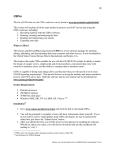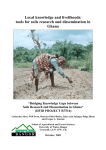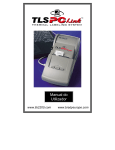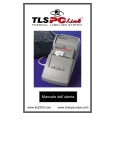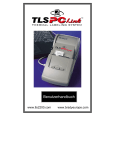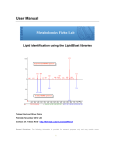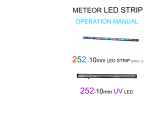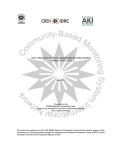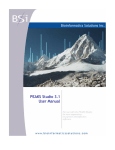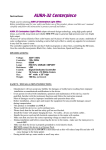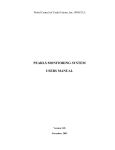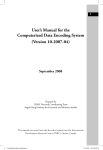Download USER GUIDE: CSPRO DATA ENTRY AND ANALYSIS SOFTWARE
Transcript
USER GUIDE: CSPRO DATA ENTRY AND ANALYSIS SOFTWARE FOR IMPLEMENTERS OF USAID POVERTY ASSESSMENT TOOLS JULY 2010 This publication was produced for review by the United States Agency for International Development. It was prepared by the IRIS Center at the University of Maryland. DISCLAIMER The author’s views expressed in this publication do not necessarily reflect the views of the United States Agency for International Development or the United States Government. 1 Contents What is CSPro? ...................................................................................................3 System Requirements ..........................................................................................3 Inital Steps ...........................................................................................................3 CSPro Overview..................................................................................................4 Data Entry application.........................................................................................5 Accessing Data That Has Been Saved ................................................................9 Modifying Data And Adding New Cases .........................................................10 Compare Data Tool ...........................................................................................10 Tabulate Frequencies Tool (Looking For Odd Values) ....................................15 Merging Data (Concatenate Data Tool) ............................................................16 Tabulating Calculation Of The Poverty Level ..................................................18 Client Assessment Survey - Ghana ...................................................................23 2 This guide will explain all of the steps needed to process your PAT survey data using the CSPro software, including: 1. Becoming familiar with the CSPro software 2. Entering, cleaning and analyzing the data 3. Reading and interpreting your results 4. Exporting your results The screen shots and examples that follow use the example of the PAT for Ghana. Practice files with which you can follow the examples on your own computer can be downloaded at www.povertytools.org. What is CSPro? The Census and Survey Processing System (CSPro) is a free software package for entering, editing, tabulating, and disseminating data from censuses and other surveys. It was designed by the United States Census Bureau, Macro International, and Serpro, S.A. CSPro can do many things above and beyond what you will need it to do to meet USAID reporting requirements. This tutorial focuses only on using the modules and menus needed to complete the steps outlined above. The features that make CSPro suitable for use with the USAID PATs include its adaptability, ability to mimic the design of a paper survey, simple point and click procedures, customized data entry with controls to minimize errors, and the ability to compare data to minimize errors. Both the software and its user manual can be downloaded at www.census.gov/ipc/www/cspro/index.html. System Requirements • Pentium processor • 256 MB of memory • SVGA monitor • Mouse and keyboard • 70 MB free disk space • Windows 98SE, ME, NT 4.0, 2000, XP, Vista or 7 1 Inital Steps 1. Download the most recent version of CSPro from www.census.gov/ipc/www/cspro/index.html. 2. Download the Data Entry Template for your country from www.povertytools.org/tools.html.2 In the examples used in this manual, this file is called “USAID_PAT_GH” (GH = Ghana). 1 CSPro does not run under other operating systems such as Linux or Mac OS. The PAT survey can also be downloaded from this website but is only used in its printed form for collecting survey data. Data is entered directly into the template in CSPro, not through the survey which is in Excel. 2 3 3. Unzip (decompress) the Data Entry Template and save the extracted files. If you want, you may delete the zipped Data Entry Template folder. 4. Recommended: make copies of the Data Entry Template (and Survey) and save them in a separate folder. This will save you the trouble of having to download them again if you make changes and need the original files. 5. Recommended: download the CSPro practice files available at www.povertytools.org/cspro.html. You can use these to follow along with the examples in this manual. CSPro Overview The following image shows the components of the unzipped Data Entry Template folder. This tutorial will focus on the following CSPro components: “Data Entry Application”, “Data Dictionary” and “Tabulation Application.” • The “Data Entry Application” is where data entry occurs. Each survey is saved as a separate “case”. Here, you can search for specific surveys or answers within a survey in addition to performing basic data entry. You can also modify previously entered cases. • The “Data Dictionary” is used to compare the contents of two data files to identify the differences, concatenate (join end-to-end or merge) two or more data files, tabulate frequencies to check for outliers, and export data to files can be imported into spreadsheets or databases. • The “Tabulation Application” is used to summarize the results of the poverty analysis program and provide an indicative summary of the relationship between poverty and household characteristics. The Files Associated with the Tabulation Application named 4 above are not to be explicitly opened; they are necessary for the Tabulation Application to run. Though you will not directly need to access these files, here are descriptions of their uses: o .xtb.app: The logic file contains the logic statements that control the tabulation application. o .xtb.mgf: The message file stores message text and an associated message number. o .xtb.wrk: This is the secondary dictionary. It contains variables and data items which are not part of the main data dictionary. o .xts: This specification file contains tables, dictionary items and value sets and other information which defines a set of tables. Data Entry application Use any country’s Data Entry Template to follow along with this section. We use the example of Ghana. This module allows you to enter data into the template. CSPro automatically saves the data entered into the template. To enter the survey data, follow these steps: 1. Double click on the CSPro Data Entry Application file in the folder in which you unzipped your template (“USAID_PAT_GH_Data_Entry_Application” below). It is the file that has a computer icon next to it. 2. The “Select Data File” window will open. To create a new file for data entry (called a “case” in CSPro), navigate to the folder in which you want to store the file (preferably the same folder that contains the CSPro applications) and type in a name for the file. Then click “Open.” 3 It is recommended that the data entry file is named to reflect who completed data entry and which records (survey numbers) were included. For example, if Ruth entered survey numbers 1 through 67, she could name the file “USAID_PAT_RUTH_1_67.” You can re-name the file later but first read the last paragraph on page 9 under “Accessing Data That Has Been Saved.” 3. When you are asked if you want to “Create the file?” click “Yes.” 3 If you want to add cases or make edits to an existing file, navigate to that file and click “Open.” 5 The data entry screen will open. Toolbar File Tree 4. There are four modes of operation within Data Entry. a. Add – Entering new cases 4. b. Modify – Modifying previously entered cases. c. Pause – Temporarily stop adding or modifying cases. d. Stop – Stop adding or modifying cases. In this mode the data entry form is not visible. 5. Colors are used to indicate the status of each field. a. White- The cursor or mouse has not moved onto that field during data entry. 4 A case corresponds to a questionnaire. Each questionnaire has a distinct survey number. 6 b. Green - The cursor or mouse has passed through that field for data entry input. All fields in a survey must be green in order for a survey to be included in the poverty calculation. c. Yellow - The cursor or mouse has passed through that field for data entry input and you have moved backwards over the field. d. Gray - The field is protected and data entry cannot occur for this field. 6. To enter data, click the first empty field (“Survey Number” in this example) and start typing. To move to the next field, use the “Enter” or “Tab” key. 7. After entering in basic client information in the top section, you will enter the “Household Roster” information in the bottom half of the screen. In Column A, the cursor moves from top to bottom. In Columns B-E (all columns but A), the cursor moves from left to right. 8. Once all household member names have been entered, the “Is this household complete?” window will open to confirm the names of all household members have been entered. You will then enter the data for each individual, one by one (left to right). Note: The template intentionally does not allow blank fields and limits the values that can be entered into some fields in order to minimize errors. For example, the Ghana survey requires the interviewer to designate the household as being in one of ten named regions. Therefore if, as in the example, you were to enter a value above 11 into the “Region” field, they would get an error telling them their value is “Out of Range”. You cannot by-pass the error message by clicking off the field. If you try to by-pass the error message, you will get an error saying “Value is out of range or missing. Value must be between x and y. Verify Response.” Until an in-range value is entered, you cannot move forward with data entry. You also cannot move forward if the field is left blank. 7 Error Message 9. When you reach the last field on the first page and press “Enter” or “Tab”, you are immediately brought to the next page of the survey. When you finish answering the last question of the entire survey, pressing “Enter” or "Tab” brings you to the next case or, if you are already in the last case, to a new case. To navigate between pages within a case, use the “Page Up” and “Page Down” keyboard keys. 10. If you have to verify a response and wish to come back to a survey later, you can “partially save” a case. To save a partially entered survey you must at minimum enter the survey number. To temporarily stop data entry, select “Stop” from the “Mode” menu, or click Save.” (stop) on the toolbar. The “Stop Adding” window will open; click “Partial 11. To resume data entry, select “Add” from the “Mode” menu, or click toolbar to add a new entry. (add) on the 8 12. When data entry is complete, from the “Mode” menu, select “Stop” or click on the toolbar and close the window. Your changes are saved automatically. (stop) IMPORTANT: As data is entered, completed fields turn green. Yellow fields indicate that the person entering data has moved backwards over it or has skipped over the field during data entry. In order to change a yellow field to green, you should not just click the field and correct the value. You should go to the first field in the survey (“Survey Number”) and click Enter or Tab until the yellow field is reached, then change the value and continue clicking Enter or Tab until the end of the survey is reached. Some users have encountered errors correcting individual values without going through the survey from beginning to end. Accessing Data That Has Been Saved When you want to access a saved input data file (add new cases or make changes), you must first open the Data Entry Application (the one with the computer icon), then open the input data file (with Type “File”) in the dialogue box that opens up. Note that there is a file with the same name as the input data file that is actually a text file. The icon for this text file looks like a sheet of ruled (lined) paper. The input data file looks like a sheet of plain paper. Program Information File Input Data File Files Associated with Input Data File Input data file: When you want to enter survey data into a new file, you create an input data file (see page 5). You may choose the location in which to store such files but we recommend saving all CSPro related files in the same folder. Creating an input data file results in the creation of four associated files with a similar name (just different file type extensions) in the same folder. You will not need to use these files but you can 9 find descriptions of their purposes below. If at any point you change the name of the input data file, however, you must also change the names of these four files. The Files Associated with the Input Data File (which you will not have to open directly) are the following: • .idx: The data file index stores the case Ids and their physical location in the data file. • .sts: The data file status file stores information about which cases are partially entered and the last field entered. • .not: The notes file stores all the notes entered by data entry operators for the corresponding data file. • text file: The text file is a .log file. This file stores operator statistics generated during data entry. Program Information File: The Program Information File acts as a shortcut to open your lastused input data file. It stores the name of the application or tool, the data file to be used and any runtime parameters specific to the application or tool. Always double check which data file you have opened when accessing the data entry template using the Program Information File. Modifying Data And Adding New Cases 1. Open the Data Entry Application. 2. Select the Input Data File containing the data you wish to modify. 3. Double click on the survey number you wish to modify OR click the survey number once and from the “Mode” menu, select “Modify.” 4. The “Survey Number” field will be automatically selected. Press “Tab” or “Enter” to advance to the field you wish to modify. DO NOT mouse click on the field – you must use the “Tab” or “Enter” key to move from field to field. While you may be able to click and modify, doing so may cause errors in the program’s operation – it is a quirk of CSPro. 5. Make the edit and then press the “Enter” or “Tab” key until reaching the end of the survey. This step is crucial to ensuring that changes are recorded properly. 6. To add a new case to an existing Input Data File, open the file and from the “Mode” menu, select “Add Case.” Compare Data Tool Use the practice files located on www.povertytools.org to follow along with the next sections. As you will be modifying data by doing so, you should first make a copy of the entire folder. Before analyzing your data, you should go through a few quality checks. The first one involves comparing data. In order to reduce data entry error, it is recommended that each survey be entered by TWO different data processors. While individuals can make errors easily (e.g, finger slips on the keyboard, entering “222” instead of “22”) it is unlikely that two people will make the same error. CSPro includes a “Compare Data” tool that allows you to compare the contents of two data files that contain the same cases (identified by Survey Number) and locate the differences. 10 The same cases (surveys) are entered twice using the Data Entry Application, preferably by two different data processors, and saved to two separate data files. For example, data entry person Mary might save her data file as “USAID_PAT_GH__Mary_100_102”, and Tina would save hers as “USAID_PAT_GH_ _Tina_100_102” (100-102 indicates that they both entered surveys numbered 100 through 102 into their data file.) To identify differences between Tina and Mary’s surveys, follow the following steps. 1. Open the Data Dictionary by doubleclicking on the CSPro Data Entry Dictionary. It is the file with the book icon next to it in your data folder. 2. Select the “Tools” menu near the top of the screen, then “Compare Data.” 3. In the file menu, select the dictionary file and click “Open.” 11 4. In the “CSDiff” window, select the variables you wish to compare. If you want to compare all variables (likely), click on the box next to the dictionary icon to select all. 5. Click on the stoplight icon in the toolbar. The “Run Compare Data” window will appear on the screen. 6. Click on the grey box to the right of “Input File:” 12 Should say Type “File”, not “Text Document”. 7. In the file menu, select the first data file (“USAID_PAT_GH_Mary_100-102”) and click Open. 8. Click on the grey box to the right of “Reference File:” and select the second data file (“USAID_PAT_GH_Tina_100102”). You can ignore the “Listing File”. 9. Click “Compare Input to Reference” and “Compare in indexed order” and click “OK.” If the two data files are not the same, the differences will appear in the “Text Viewer” Window. 13 Case Id = Survey Number Item = Question Number To save the output that shows the differences, select “File” at the top of the screen. In the “File” menu select ‘Save As.” Name and save the file in the folder with the Template. Follow the instructions for modifying the data on page 10 to correct any errors you find. If there is any doubt as to what a correct value should be, go back to the paper survey and verify what is written. When you close the program and are asked if you want to save changes, click ‘Yes’. Once you have corrected the data, rename 5 one set of files to indicate it has gone through the “Compare Data” check (“USAID_PAT_GH_ 100-102c” – we use ‘c’ to indicated the file has been compared with another). IMPORTANT: When the data entry file is renamed, the .idx, text, .lst, .not, and .sts files must also be renamed to reflect the Input Data File name change. 5 Re-name it in the folder in which it’s stored by right-clicking the file name and selecting “Rename.”. Remember that you must rename each of the associate files sharing that name. 14 Tabulate Frequencies Tool (Looking For Odd Values) Survey errors made by Interviewers (or bad handwriting!) can sometimes be found even after surveys have gone through a number of quality control checks. For this reason, we run “frequency” calculations on our databases to look for survey answers that just do not look right. 1. Open the Data Entry Dictionary. It is the file with the book icon next to it in your data folder. 2. Select the “Tools” menu near the top of the screen. Select “Tabulate Frequencies.” 3. Double click on the data dictionary file, “USAID_PAT_GH_Data_Entry.” 4. In the “CSFreq” window, select the variables for which you would like to generate frequency statistics. If you want to compare all variables (likely), click on the box next to the dictionary icon to select all. 5. On the right side of the “CSFreq” window, select Type of Frequencies: “Each Value Found”, Generate Statistics: “Yes”, and Method of Saving Selected Items: “Save Included Items.” 6. Click on the stoplight icon in the toolbar. The “Select Data File(s) to Tabulate” window will appear on the screen. 15 7. Double click on the data file you wish to use (“USAID_PAT_GH__100-102c”). 8. The frequencies are presented in the “CSFrqRun” widow. Click on the name of an individual question to see the frequency of responses. 9. Once corrections have been made, rename the data input file and its associated files to reflect that the frequencies check is complete (“USAID_PAT_100_105cf”). 10. When you exit the program and are asked to save changes, select ‘Yes’. Merging Data (Concatenate Data Tool) If different surveys are entered into two different data files, they will need to be merged. The “Concatenate Data” tool is used to perform this function. In this example we will be merging “USAID_PAT_GH_100-102cf” and “USAID_PAT_GH_103-105cf” into one new file. 1. Open the Data Entry Dictionary. It is the file with the book icon next to it. 2. Select the “Tools” menu near the top of the screen. Select “Concatenate Data.” 16 3. The “CSConcat” window opens. 4. The output file is the file that receives the results of the concatenation (the file that contains the merged data). Press the “Browse” button and name an output file into which separate databases will be merged 6. We will name this output file “USAID_PAT_GH_Final_100-105” because we are merging “USAID_PAT_GH_100-102cf and “USAID_PAT_GH_103-105cf .” In the “Output File” box enter “USAID_PAT_GH_Final_100-105.” 5. Click “Add.” The “Select Files to Concat” window opens. Double click on “USAID_PAT_GH_100-102cf .” 6. Click “Add” again. Double click on “USAID_PAT_GH_103-105cf .” The order of the list of files to concatenate is the order of concatenation. To change the order of concatenation you need to rearrange the file names in the list. You can rearrange the names by drag and drop or sorting. 7. When you see the files you wish to merge listed, click “Run.” 7 When the merging is complete, a box will say “Concatenate completed!” 6 It will look as if you should be searching for a file but instead, you should type in a new file name. Merging into an existing file will over-write its contents. 7 It is possible to merge more than two files together into one document. Continue using the Add button until you have added all the files you want to merge into one list. 17 8. Then, the CSPro Text Viewer will open a window that contains a summary of the merging process. CSPro will give you a message indicating whether the merging process was successful or unsuccessful. Tabulating Calculation Of The Poverty Level 1. The poverty calculation program is run as data is entered into the Data Entry Application. The results of the poverty calculation program are summarized using the Tabulation Application. To summarize the results of the poverty calculation program, complete the following steps. Open the Tabulation Application by double clicking on the CSPro CrossTab Application Document file. It is the file with red box next to it (see the figure below). 18 2. Click on the stoplight icon in the toolbar. The “Define Tab File Associations” window will appear on the screen. 3. Click on the grey box to the right of “<Input Data>.” Double click on the final data file “USAID_PAT_GH_Final_100-105.” Then click “OK.” 4. The results show the percentage of clients living above and below a certain poverty line. The result for Microenterprise Results Reporting (MRR) is highlighted in yellow. In this example, 0% of households live below the $0.75 a day poverty line; 0% of households live below the $1.00 a day poverty line; 0% of households live below the $1.25 a day poverty line; 16.7% of households live below the $2.00 a day poverty line; and 33.3% of households live below the $2.50 a day poverty line. It should be noted that the model is calibrated to both the $1.25 and $2.50 lines, but not the other lines. The results at the other lines are likely less accurate and should be used for indicative purposes. The table also shows, for reference purposes, the percentage of households living below different PPP poverty line for the survey data used to construct the PAT. 19 5. Scroll down to see the results for more poverty lines. The results to be used for MRR reporting will be highlighted. 20 Exporting Data Tool The “Export Data” Tool is a tool that you may find useful in analyzing your survey data. The tool allows you to export data from a CSPro input data file to tab or comma delimited text files that can be imported into spreadsheets or databases. For easier import into spreadsheets and databases, household and individual level data should be exported separately. To export household level data complete the following steps. 1. Open the Data Dictionary by doubleclicking on the CSPro Data Entry Dictionary. It is the file with the book icon next to it in your data folder. 2. Select the “Tools” menu near the top of the screen, then “Export Data.” 3. In the file menu, select the dictionary file and click “Open.” 21 Do not select 4. In the “CSExport” window, click every box but the one next to “Household Roster” in the data dictionary tree. 5. In the “CSExport” window, click “One File”, “All in One Record”, and “Comma delimited (.csv).” 6. Click on the stoplight icon in the toolbar. The “Select Data File(s) to Export” window will appear on the screen. 7. In the file menu, select the data file you want to export and click “Open.” 8. In the “Specify Name of Exported File” window, enter the file name and click “Save.” 9. The “Text Viewer” window will open, you can close the window. 10. To open the file in Excel, first open the Excel program, select Open from the main menu, and open the saved file. If you do not see it listed, change “Files of Type:” to “All Files.” 22 Client Assessment Survey - Ghana Interviewer: Text in bold should be read aloud. Text in italics are instructions and should not be read aloud. You should use probing questions if necessary to elicit responses to all questions. If, however, a response is still not forthcoming, the following codes should be used: 99 - not applicable; 98 - no response given. Fill out the information below before the survey begins. Do not ask the respondent for this information. Date of Interview Months in Program Interviewer (code) Client or ID # Branch (code) Quality Control Checks Region 1 □ Western 2 □ Central 3 □ Greater Accra 4 5 □ Eastern 6 □ Ashanti 7 □ Brong-Ahafo 8 □ Northern 9 □ Upper East 10 □ Upper West □ Volta Client Location 0 □ Urban Field Supervisor Date Initials Headquarters Date Initials Data Processor Date Initials 1 □ Rural Hello. My name is ___. I work for the organization ___. We are conducting a survey to learn a little bit more about the clients we work with. My records indicate that [name] is the main point of contact between [organization] and your household. May I please speak to [name]? If person is desired respondent, read only the instructions marked 2. If person is NOT desired respondent, read both 1 and 2 when desired respondent is located. 1. Hello. My name is ___. I work for the organization ___. We are conducting a survey to learn a little bit more about the clients we work with. My records indicate that you are the point of contact between [organization] and your household. 2. The interview should only take about 20 minutes and your answers will be put together with answers from other households. All of your answers are completely confidential and your name will not be given with your answers. Are you willing to answer these questions today? After he/she agrees, proceed with the text below. 23 First, I would like to ask you about your household. Let me tell you what we mean by 'household.' For our purposes today, a household consists of a person or group of persons who live together, acknowledge one shared head of the household, and share housekeeping and cooking arrangements. Do you have any questions? Answer any questions the respondent has before proceeding. Now I would like you to identify each person in your household and answer some basic questions about each person. Let's start with the names of each person in your household. Shall I identify you as [name]? If the respondent is reluctant to provide his or her name or those of others in the household, record relationships instead (ex: Respondent, Husband, etc). Use row 1 for respondent. Are you the head of the household or is someone else? If not the respondent, record the Head of Household’s name next, then continue filling in column A with each household member before asking questions in the remaining columns. A. Household Member's Name B. Is [name] female or male? C. What is the relationship of [name] to [household head]? D. How old is [name]? 1. Female…..0 Male……...1 Head …..………...…..……...…..1 Spouse ……..……..…......….....2 Child ……....…...….....…….….3 Parent …….......………...….....4 Sibling ….………...….…........5 Grandparent ……..……........6 Grandchild …………..….......7 Daughter-/son-in-law .…........8 Other relative ………..….........9 Non-relative ………..…....…......10 (complete years) Only ask if age 3 or older. E. What was [name]'s highest educational qualification attained? Under age 3 ..............................99 None …….……....................….....1 MLSC …........…..…..........….…...2 BECE …........................…….…3 Voc/Comm ……........…..........…4 Teacher Tra. A ….................…5 Teacher Post Sec ....................…6 GCE O Level …......................…7 SSCE .......…............................…8 GCE A Level ….......................…9 Tech/Prof Cert …....................…10 Tech/Prof Dip ….....................…11 HND ......................................…12 Bachelors ...............................…13 Masters ..................................…14 Doctorate ...............................…15 Other ....................................…..16 1) 2) 3) 4) 5) 6) 7) 8) 9) 10) 11) 12) Next, I would like to ask you a few questions about your home. 24 2. How many rooms does this household occupy? (Count living rooms, dining rooms, and bedrooms, but not bathrooms, toilets or the kitchen.) 3. How does your household dispose of refuse? 1□ 2□ 3□ 4□ 5□ 4. What type of toilet is used by your household? Dumped elsewhere Burned by household Buried by household Other 1□ Flush toilet (W.C.) 2□ 4□ 5□ 6□ 7□ What is the main construction material used for the floor? Public dump 6□ 3□ 5. Collected Pit latrine KVIP Pan/bucket Public toilet (flush/bucket/KVIP) Toilet in another house No toilet facility (bush, beach) 8□ Other 1□ Earth/mud/mud bricks 2□ 3□ 4□ 5□ 6□ 7□ 8□ 9□ Wood Stone Cement/concrete Burnt bricks Vinyl tiles Ceramic/marble/tiles Terrazzo Other Next, I would like to ask you about a few items that members of your household may own. Does any member of the household own… 6. A working sewing machine? 7. A working gas stove? 8. A working fan? 9. A working video cassette player? 10. A working television? 11. A working electric iron? 12. A house? 13. Land or a plot? No □ 0 □ 0 □ 0 □ 0 □ 0 □ 0 □ 0 □ 0 Yes □ 1 □ 1 □ 1 □ 1 □ 1 □ 1 □ 1 □ 1 Look over the survey to see if you have missed any questions, then end the interview. Those are all the questions I need to ask you today. Thank you for your time and effort in completing this survey. 25

























